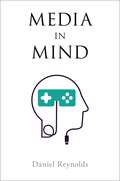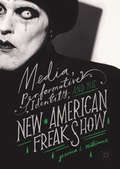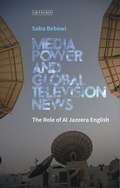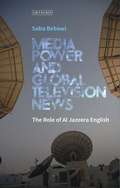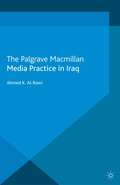- Table View
- List View
Media, Home and Family
by Stewart M. Hoover Lynn Schofield Clark Diane F. AltersBased on extensive fieldwork, this book examines how parents make decisions regulating media use, and how media practices define contemporary family life.
Media, Home and Family
by Stewart M. Hoover Lynn Schofield Clark Diane F. AltersBased on extensive fieldwork, this book examines how parents make decisions regulating media use, and how media practices define contemporary family life.
Media in Mind
by Daniel ReynoldsWhere do you end, and where do media begin? In Media in Mind, author Daniel Reynolds draws upon naturalist philosophies of the mind from John Dewey through contemporary theories of embodied and extended cognition to make the case that the lines separating media from the minds of their users are not blurry or variable so much as they never existed to begin with. Through analyses of films and video games from 1900 to the present, Media in Mind shows how media forms and technologies challenge dominant models of perception and mental representation, and how they complicate theoretical understanding of concepts like the platform and the interface. In order to do justice to the profound and literally mind-changing power of media, Reynolds argues, we need to think not so much about the relationship between media and the mind as about the roles that media play in our minds. Through this crucial distinction, Media in Mind surveys more than a century of media theory to illustrate the ways that scholars of film and digital media have situated and reconsidered a series of divisions between media, user, and world, and how these conceptual divisions have reflected and inflected their ways of understanding the mind.
Media Law
by Sallie SpilsburyThe aim of this book is to analyse media law in relation to specific areas,both in terms of its practical application and its theoretical framework. Part 1 concentrates on the regulation of media content and is largely written from a pro media point of view. Its central tenet is how far does the English media enjoy freedom of expression and the way in which that impacts on how the media operates. It considers how the Human Rights Act 1998 impacts on the media. Part 2 moves on to look at the regulation of the media industries as a whole. Part 3 focuses on day to day transactions for the media. In particular it focuses on provisions from typical media agreements and aims to provide a context for the law which has been outlined in Parts 1 and 2. The structure of this book bridges the gap between a traditional textbook and practitioner work and provides a book which will be of interest to law degree and LPC students and practitioners.
Media Law
by Sallie SpilsburyThe aim of this book is to analyse media law in relation to specific areas,both in terms of its practical application and its theoretical framework. Part 1 concentrates on the regulation of media content and is largely written from a pro media point of view. Its central tenet is how far does the English media enjoy freedom of expression and the way in which that impacts on how the media operates. It considers how the Human Rights Act 1998 impacts on the media. Part 2 moves on to look at the regulation of the media industries as a whole. Part 3 focuses on day to day transactions for the media. In particular it focuses on provisions from typical media agreements and aims to provide a context for the law which has been outlined in Parts 1 and 2. The structure of this book bridges the gap between a traditional textbook and practitioner work and provides a book which will be of interest to law degree and LPC students and practitioners.
Media Law for Producers
by Philip MillerMedia Law for Producers is a comprehensive handbook that explains, in lay terms, the myriad legal issues that the producer will face on a regular basis - contracts, permits, defamation, patents, releases and insurance, libel, royalties and residuals, as well as protecting the finished production. This revised and expanded edition includes such Internet-related topics as Internet music law, online registration, and online privacy. Other new topics covered include:· Implied and express contracts in the project/idea submission process · Assignment/transfer of copyright· Music clip licensing· Use of other people's trademarks in media production· Parody as a defense to copyright infringement Clear explanations examine the how and why of different types of production contracts, and checklists provide a quick means for producers to determine when their productions might be at greatest risk to legal challenges. Media Law for Producers also examines the substantial changes in copyright term resulting from recent copyright legislation. Legal problems can be very costly to media producers. Lawyers and court fees, coupled with the loss of work time, can lead to bankruptcy. Media Law for Producers cuts through the legalese and illustrates legal issues to help producers recognize the legal questions that can arise during production.
Media Law for Producers
by Philip MillerMedia Law for Producers is a comprehensive handbook that explains, in lay terms, the myriad legal issues that the producer will face on a regular basis - contracts, permits, defamation, patents, releases and insurance, libel, royalties and residuals, as well as protecting the finished production. This revised and expanded edition includes such Internet-related topics as Internet music law, online registration, and online privacy. Other new topics covered include:· Implied and express contracts in the project/idea submission process · Assignment/transfer of copyright· Music clip licensing· Use of other people's trademarks in media production· Parody as a defense to copyright infringement Clear explanations examine the how and why of different types of production contracts, and checklists provide a quick means for producers to determine when their productions might be at greatest risk to legal challenges. Media Law for Producers also examines the substantial changes in copyright term resulting from recent copyright legislation. Legal problems can be very costly to media producers. Lawyers and court fees, coupled with the loss of work time, can lead to bankruptcy. Media Law for Producers cuts through the legalese and illustrates legal issues to help producers recognize the legal questions that can arise during production.
Media Management and Artificial Intelligence: Understanding Media Business Models in the Digital Age
by Alex ConnockThis cutting-edge textbook examines contemporary media business models in the context of Artificial Intelligence (AI) and digital transformation. AI has dramatically impacted media production and distribution, from recommendation engines to synthetic humans, from video-to-text tools to natural language models. "AI is really the change agent of the media industry," answered a natural language generation model when AI was ‘asked’ about the subject of this book. "It will open incredible opportunities." This book seeks to explore them. The media is examined through four sections. ‘Principles’ maps business models and the key tools of AI. ‘Platforms’ covers distribution channels in Games, Streamers, Social Networks, Broadcast and Digital Publishing. ‘Producers’ covers the engines of content-making, including Scripted, Entertainment, Factual, Content Marketing, Creators and Music. Finally, ‘Pioneers’ covers emerging sectors of Podcasting, Esports, the Metaverse and other AI-driven developments. Then in each chapter, a standard value creation model is applied, mapping a single sector through development, production, distribution and monetisation. Diverse case studies are analysed from India, Nigeria, South Korea, South Africa, France, the Netherlands, the US, the UK, Denmark and China – around creative entrepreneurship, revenue models, profit drivers, rights and emerging AI tools. Questions are provided for each case, whilst chapter summaries cement learning. Applied and technology-focused, this text offers core reading for advanced undergraduate and postgraduates studying Media Management – or the relationship between Entertainment, Media and Technology. Online resources include chapter-by-chapter PowerPoint slides and an Instructor’s Manual with further exercises and case studies.
Media Management and Artificial Intelligence: Understanding Media Business Models in the Digital Age
by Alex ConnockThis cutting-edge textbook examines contemporary media business models in the context of Artificial Intelligence (AI) and digital transformation. AI has dramatically impacted media production and distribution, from recommendation engines to synthetic humans, from video-to-text tools to natural language models. "AI is really the change agent of the media industry," answered a natural language generation model when AI was ‘asked’ about the subject of this book. "It will open incredible opportunities." This book seeks to explore them. The media is examined through four sections. ‘Principles’ maps business models and the key tools of AI. ‘Platforms’ covers distribution channels in Games, Streamers, Social Networks, Broadcast and Digital Publishing. ‘Producers’ covers the engines of content-making, including Scripted, Entertainment, Factual, Content Marketing, Creators and Music. Finally, ‘Pioneers’ covers emerging sectors of Podcasting, Esports, the Metaverse and other AI-driven developments. Then in each chapter, a standard value creation model is applied, mapping a single sector through development, production, distribution and monetisation. Diverse case studies are analysed from India, Nigeria, South Korea, South Africa, France, the Netherlands, the US, the UK, Denmark and China – around creative entrepreneurship, revenue models, profit drivers, rights and emerging AI tools. Questions are provided for each case, whilst chapter summaries cement learning. Applied and technology-focused, this text offers core reading for advanced undergraduate and postgraduates studying Media Management – or the relationship between Entertainment, Media and Technology. Online resources include chapter-by-chapter PowerPoint slides and an Instructor’s Manual with further exercises and case studies.
The Media of Testimony: Remembering the East German Stasi in the Berlin Republic (Palgrave Macmillan Memory Studies)
by S. JonesThe Media of Testimony explores testimony relating to the Stasi in different cultural forms: autobiographical writing, memorial museums and documentary film. Combining theoretical models from diverse disciplines, it presents a new approach to the study of testimony, memory and mediation.
Media Parasites in the Early Avant-Garde: On the Abuse of Technology and Communication (Avant-Gardes in Performance)
by A. NiebischNiebisch retraces how the early Avant-Garde movements started out as parasites inhabiting and irritating the emerging mass media circuits of the press, cinema, and wired and wireless communication and how they aimed at creating a media ecology based on and inspired by technologies such as the radio and the photo cell.
Media, Performative Identity, and the New American Freak Show
by Jessica L. WilliamsThis book traces how the American freak show has re-emerged in new visual forms in the 21st century. It explores the ways in which moving image media transmits and contextualizes, reinterprets and appropriates, the freak show model into a “new American freak show.” It investigates how new freak representations introduce narratives about sex, gender, and cultural perceptions of people with disabilities. The chapters examine such representations found in horror films, including a prolonged look at Freaks (1932) and The Texas Chainsaw Massacre (1974), documentaries such as Murderball (2005) and TLC’s Push Girls (2012-present), disability pornography including the pornographic documentary Sick: The Life and Death of Bob Flanagan Supermasochist (1997), and the music icons Marilyn Manson and Lady Gaga in their portrayals of disability and freakishness. Through this book we learn that the visual culture that has emerged takes the place of the traditional freak show but opens new channels of interpretation and identification through its use of mediated images as well as the altered freak-norm relationship that it has fostered. In its illumination of the relationship between normal and freakish bodies through different media, this book will appeal to students and academics interested in disability studies, gender studies, film theory, critical race theory, and cultural studies.
Media, Performative Identity, and the New American Freak Show
by Jessica L. WilliamsThis book traces how the American freak show has re-emerged in new visual forms in the 21st century. It explores the ways in which moving image media transmits and contextualizes, reinterprets and appropriates, the freak show model into a “new American freak show.” It investigates how new freak representations introduce narratives about sex, gender, and cultural perceptions of people with disabilities. The chapters examine such representations found in horror films, including a prolonged look at Freaks (1932) and The Texas Chainsaw Massacre (1974), documentaries such as Murderball (2005) and TLC’s Push Girls (2012-present), disability pornography including the pornographic documentary Sick: The Life and Death of Bob Flanagan Supermasochist (1997), and the music icons Marilyn Manson and Lady Gaga in their portrayals of disability and freakishness. Through this book we learn that the visual culture that has emerged takes the place of the traditional freak show but opens new channels of interpretation and identification through its use of mediated images as well as the altered freak-norm relationship that it has fostered. In its illumination of the relationship between normal and freakish bodies through different media, this book will appeal to students and academics interested in disability studies, gender studies, film theory, critical race theory, and cultural studies.
Media Perspectives for the 21st Century (Communication and Society)
by Stylianos PapathanassopoulosMedia Perspectives for the 21st Century brings together key international scholars to explore concepts, topics and issues concerning the communication environment in contemporary democratic societies. It combines qualitative and quantitative approaches to provide an interdisciplinary and truly global perspective that reflects the trends, theories and issues in current media and communication research. The collection raises significant questions about the study of the media by challenging approaches to major media and societal issues, and analyses in more depth the range of concerns that shape both the present and the future media landscape and the issues these can create for communication. It also investigates the main effects of technological developments on the domain of the news media and journalism. Divided into two main sections, Part I provides accounts of the role of the media in society, and deals with agendas that affect the field of communications studies. Part II goes on to examine the world of new media and offers analyses on the developments of the 21st century. Chapters deal with various dimensions of media from a number of different perspectives and socio-political contexts, covering a wide range of topics including Social Networking, Political Communication, Public Journalism, Global Infotainment and Consumer Culture. Media Perspectives for the 21st Century will be highly useful to undergraduate and postgraduate students, as well as researchers and academics, in the fields of media and communication studies, mass communication, journalism and new media.
Media Perspectives for the 21st Century (Communication and Society)
by Stylianos PapathanassopoulosMedia Perspectives for the 21st Century brings together key international scholars to explore concepts, topics and issues concerning the communication environment in contemporary democratic societies. It combines qualitative and quantitative approaches to provide an interdisciplinary and truly global perspective that reflects the trends, theories and issues in current media and communication research. The collection raises significant questions about the study of the media by challenging approaches to major media and societal issues, and analyses in more depth the range of concerns that shape both the present and the future media landscape and the issues these can create for communication. It also investigates the main effects of technological developments on the domain of the news media and journalism. Divided into two main sections, Part I provides accounts of the role of the media in society, and deals with agendas that affect the field of communications studies. Part II goes on to examine the world of new media and offers analyses on the developments of the 21st century. Chapters deal with various dimensions of media from a number of different perspectives and socio-political contexts, covering a wide range of topics including Social Networking, Political Communication, Public Journalism, Global Infotainment and Consumer Culture. Media Perspectives for the 21st Century will be highly useful to undergraduate and postgraduate students, as well as researchers and academics, in the fields of media and communication studies, mass communication, journalism and new media.
Media, Persuasion and Propaganda (Media Topics)
by Marshall SoulesUsing case studies and exercises, this innovative study guides the reader through the many varieties of persuasion and its performance, exploring the protocols of rhetoric unique to the medium, from orality and print to film and digital images.
Media, Persuasion and Propaganda (Media Topics)
by Marshall SoulesUsing case studies and exercises, this innovative study guides the reader through the many varieties of persuasion and its performance, exploring the protocols of rhetoric unique to the medium, from orality and print to film and digital images.
Media Power and Global Television News: The Role of Al Jazeera English
by Saba BebawiThe Middle East has been a particular focus of global crisis reporting. Yet, international coverage of these conflicts has historically been presented through a 'Western' perspective. The absence of Arab voices in the global public sphere has created a discursive gap between the Middle East and the rest of the world. The arrival of Al Jazeera English might, therefore, be regarded as an attempt to bridge this gap by broadcasting discourses from and about the Arab world. Using a framing analysis of selected news reports by Al Jazeera English before and after the so-called 'Arab Spring' protests, this book considers Al Jazeera English's position in the global news environment and identifies the extent to which it addresses this gap between the Arab and global spheres.
Media Power and Global Television News: The Role of Al Jazeera English (International Media and Journalism Studies)
by Saba BebawiThe Middle East has been a particular focus of global crisis reporting. Yet, international coverage of these conflicts has historically been presented through a 'Western' perspective. The absence of Arab voices in the global public sphere has created a discursive gap between the Middle East and the rest of the world. The arrival of Al Jazeera English might, therefore, be regarded as an attempt to bridge this gap by broadcasting discourses from and about the Arab world. Using a framing analysis of selected news reports by Al Jazeera English before and after the so-called 'Arab Spring' protests, this book considers Al Jazeera English's position in the global news environment and identifies the extent to which it addresses this gap between the Arab and global spheres.
Media Practice in Iraq
by A. Al-RawiA historical survey of the Iraqi media from its beginning up to the present day, focusing on the post-2003 media scene and the political and societal divisions that occurred in Iraq after US-led occupation. Investigates the nature of the media outlets and offers an analysis of the way Iraqi satellite channels covered the 2010 general elections.
Media Practices, Social Movements, and Performativity: Transdisciplinary Approaches (Routledge Research in Cultural and Media Studies)
by Susanne Foellmer Margreth Lünenborg Christoph RaetzschAs individuals incorporate new forms of media into their daily routines, these media transform individuals’ engagement with networks of heterogeneous actors. Using the concept of media practices, this volume looks at processes of social and political transformation in diverse regions of the world to argue that media change and social change converge on a redefinition of the relations of individuals to larger collective bodies. To this end, contributors examine new collective actors emerging in the public arena through digital media or established actors adjusting to a diversified communication environment. The book offers an important contribution to a vibrant, transdisciplinary, and international field of research emerging at the intersections of communication, performance and social movement studies.
Media Practices, Social Movements, and Performativity: Transdisciplinary Approaches (Routledge Research in Cultural and Media Studies)
by Susanne Foellmer Margreth Lünenborg Christoph RaetzschAs individuals incorporate new forms of media into their daily routines, these media transform individuals’ engagement with networks of heterogeneous actors. Using the concept of media practices, this volume looks at processes of social and political transformation in diverse regions of the world to argue that media change and social change converge on a redefinition of the relations of individuals to larger collective bodies. To this end, contributors examine new collective actors emerging in the public arena through digital media or established actors adjusting to a diversified communication environment. The book offers an important contribution to a vibrant, transdisciplinary, and international field of research emerging at the intersections of communication, performance and social movement studies.
Media Representations of Police and Crime: Shaping the Police Television Drama (Critical Criminological Perspectives)
by M. ColbranThis unique book explores the social processes which shape fictional representations of police and crime in television dramas. Exploring ten leading British and European police dramas from the last twenty-five years, Colbran, a former scriptwriter, presents a revealing insight into police dramas, informed by media and criminological theory.
Media Representations of the Cultural Other in Turkey
by Alparslan Nas“A fresh study that confirms the existence of multiple peripheries (and its others) in Turkish society and how dominant centrist media represented these differences in film and television discourse. The use of Mardin’s center-periphery concept for the analyses of films, ads and cartoons is brilliant. This is a timely project as scholarly interest in Turkey has increased exponentially since 2013. This project is key to understanding the roots of a media politics in contemporary Turkey.”—Murat Akser, Ulster University, UK“Alparslan Nas' seminal work disrupts the notion of Turkish identities as fixed and stable. He challenges the center (secular, modern, Western)/ peripheral (conservative, religious) binary by critically examining how a cultural “other” is constructed and performed through the media in Turkey. Nas’ analysis offers a (much needed) new lens and approach to understanding Turkey’s complex social and political landscape.”—Kathleen Cavanaugh, National University of Ireland, Galway, IrelandThis book is an important contribution to the scholarship on Turkey’s cultural and political dynamics, facilitating a discussion on the recent depictions of the cultural other in the media. Turkey’s modern history has been characterized by a particular tension between the social classes occupying the “center” of society: while the bureaucratic elite are represented as modern, secular and westernized, the “peripheral” communities are portrayed as conservative, religious or non-Turkish. This book facilitates a timely intervention to problematize this possible perception and to point at the complex dynamics of center-periphery relations through the representation of the cultural other in film, television, advertisements and cartoons, which have all been produced by different social classes. Ultimately, Media Representations of the Cultural Other in Turkey argues that the notions of the center and periphery do not signify stable positions; rather, each social agent imagines themselves at the center, the cultural other at their periphery providing a crucial tool for the realization of their own identity.
Media Representations of the Cultural Other in Turkey
by Alparslan Nas“A fresh study that confirms the existence of multiple peripheries (and its others) in Turkish society and how dominant centrist media represented these differences in film and television discourse. The use of Mardin’s center-periphery concept for the analyses of films, ads and cartoons is brilliant. This is a timely project as scholarly interest in Turkey has increased exponentially since 2013. This project is key to understanding the roots of a media politics in contemporary Turkey.”—Murat Akser, Ulster University, UK“Alparslan Nas' seminal work disrupts the notion of Turkish identities as fixed and stable. He challenges the center (secular, modern, Western)/ peripheral (conservative, religious) binary by critically examining how a cultural “other” is constructed and performed through the media in Turkey. Nas’ analysis offers a (much needed) new lens and approach to understanding Turkey’s complex social and political landscape.”—Kathleen Cavanaugh, National University of Ireland, Galway, IrelandThis book is an important contribution to the scholarship on Turkey’s cultural and political dynamics, facilitating a discussion on the recent depictions of the cultural other in the media. Turkey’s modern history has been characterized by a particular tension between the social classes occupying the “center” of society: while the bureaucratic elite are represented as modern, secular and westernized, the “peripheral” communities are portrayed as conservative, religious or non-Turkish. This book facilitates a timely intervention to problematize this possible perception and to point at the complex dynamics of center-periphery relations through the representation of the cultural other in film, television, advertisements and cartoons, which have all been produced by different social classes. Ultimately, Media Representations of the Cultural Other in Turkey argues that the notions of the center and periphery do not signify stable positions; rather, each social agent imagines themselves at the center, the cultural other at their periphery providing a crucial tool for the realization of their own identity.

